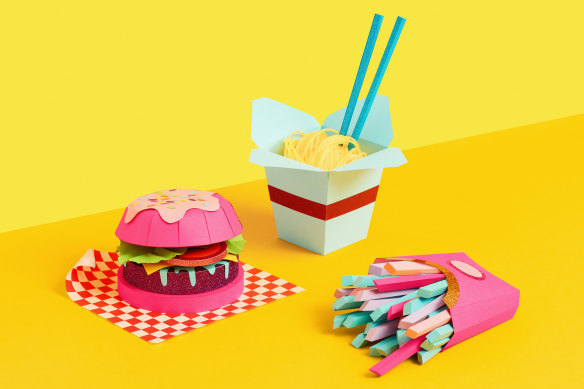Why do ultra-processed foods make us so sad?

Save articles for later
Add articles to your saved list and come back to them any time.
What we do with and put in our bodies does far more than affect our physical health. A growing body of research reveals the impact of our diet and the way we move (or not) on our mental health.
A new study, by researchers from the University of South Australia, found that exercise, particularly high intensity exercise, was more effective at managing symptoms of depression and anxiety than standard treatments.
Barely even foods: Ultraprocessed foods have a unique way of making us sick and sad. Credit: Getty
A separate new study, published in the Journal of Affective Disorders, found that a diet high in ultra-processed foods (UPFs) can increase the risk of depression by as much as 23 per cent.
There was a dose-response, explains lead author Dr Melissa Lane, from Deakin University’s Food and Mood Centre, meaning that the likelihood of developing depression jumps when ultra-processed foods make up around 30 per cent of the total diet.
About one in five Australians over the age of 16 experiences a mental illness in any one year, with depression being one of the most common. By some estimates, ultra-processed foods account for nearly 40 per cent (38.8 per cent) of the average Australian adult’s diet.
Our mental health is made up of many parts, including our experiences, our environment, our relationships, our genetics, and also our diet and physical activity levels.
This is the first study to look at the associations between UPFs and depression in Australia.
And although the association is believed to cut both ways – we feel bad, so we eat badly, and we eat bad, so we feel badly – the researchers attempted to control for this in their study.
They did this by excluding people who were taking medications for depression and anxiety at the start of the study. “This suggests that the people leftover started the study without depression and then went on to develop it over time and owing to UPF consumption,” Lane says.
What are UPFs and what makes them uniquely bad?
Baking a batch of biscuits at home is different to eating UPFs, but why? It’s not just about sugar, Lane explains, although what we make at home is likely to have less sugar (and salt and fat).
We can spot UPFs because they are typically packaged in plastic and have one or more ingredients that we don’t tend to have at home including alphanumeric additives like emulsifiers, humectins, stabilisers, colourants and flavours. They barely resemble food at all and are instead, as the author of a new book on UPFs put it, “addictive edible substances”.
“We try not to refer to UPFs as junk foods because these products aren’t limited to fast foods like McDonalds and KFC,” Lane adds.
“UPFs include many products that might be considered by consumers as ‘neutral’ or even ‘healthy’ like flavoured yoghurts, diet soft drinks, protein bars, packaged preparations such as scrambled eggs, mashed potatoes and many ready-to-h/eat convenience foods.”
The issue isn’t just sugar, salt and fat, which are commonly used to assess the ‘health potential’ of foods, she explains, it’s also that we don’t know the possible combined effects of multiple additives.
And though researchers don’t fully understand why UPFs are such a scourge on the health of our brains (as well as our bodies), they have a few ideas.
Depression is considered an inflammatory disease and nutrient-poor foods are more likely to cause inflammation and oxidative stress, says Dr Rebecca Reynolds, a nutritionist and adjunct lecturer at the University of New South Wales.
The additives in UPFs can also change the bacteria that live in the gut in a pro-inflammatory way.
“On top of potential negative nutritive aspects of UPFs, there are possible compounds produced during food processing – such as AGEs (advanced glycation end products) and artificial additives (e.g., saccharin and MSG) – that may affect brain neurotransmitter functioning,” Reynolds says, adding: “BPA in food packaging has been linked to hormone dysregulation that may affect mood.”
What happens when we swap UPF for (mostly) fresh?
Swapping out UPFs for less processed alternatives (obviously fresh fruit and vegetables, fish, legumes and seeds, whole grains and olive oil but also tinned and frozen foods) can alleviate symptoms of depression as quickly as three weeks according to one study and within about 12 weeks according to multiple others.
While a healthy diet – like a Mediterranean-style diet – supports cognitive function, may improve markers of inflammation and gut health and therefore perhaps mental health, there is another reason why improving diet can improve mental health.
Dr Grant Blashki, the lead clinical advisor at Beyond Blue, always encourages people who are recovering from mental illness issues to focus on eating well.
“It’s about getting yourself better, and it’s also part of the psychological activities we like people to do,” he explains. “You have to plan and shop and when you’re cooking, there’s quite a lot of mindfulness in that. You’re using your senses – you’re smelling and tasting and then hopefully, if you’re able to, you’re sharing with others and there’s that sense of connection. There’s something ancient and nurturing about eating well.”
One way to improve our diet is to read the ingredients lists on packaged products. Lane suggests specifically looking out for unfamiliar substances like alphanumeric additives.
Lane reminds that the point is not to blame or shame anyone for their diet. We are the victims of a predatory industry that needs to be regulated.
“This will essentially require action from the government and a multipronged approach including taxation, front-of-packet warning labels, marketing restrictions, getting these products out of learning environments and health organisations and getting the UPF industry out of the policy-making room.”
Make the most of your health, relationships, fitness and nutrition with our Live Well newsletter. Get it in your inbox every Monday.
Most Viewed in Lifestyle
From our partners
Source: Read Full Article
